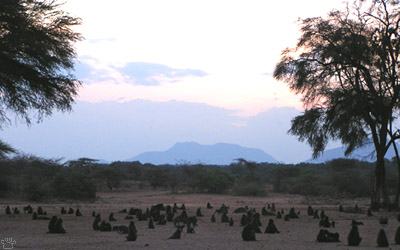
Every evening, families of olive baboons (Papio anubis) bring their kids to this dry river bed
to quietly watch the sunset. Buffalo Springs Game Reserve, Kenya
.
East Africa - Part 2. African Nights
In Africa, as elsewhere, most animals are active at night. Of course, you are not allowed to walk or drive around at night in any National park or game reserve in East Africa. You must stay in your lodge or campground, protected by an "armed guard" - usually a teenager armed with an old Chinese-made AK-47, who is supposed to save you if a lion sneaks into your tent at 3 AM. I think the only purpose of having that guard is that he would take the blame if something happens. A few lodges organize night drives, but these are very expensive and run by people who have no idea how to do it.
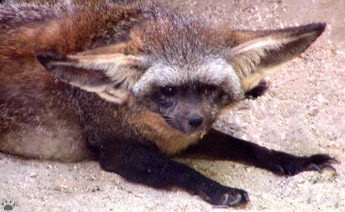
Bat-eared fox (Otocyon megalotis) is a common insectivorous species of shortgrass
savanna. Amboseli National Park, Kenya. |
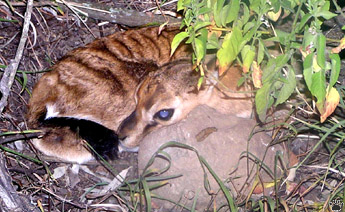
Newborn Thompson's gazelle (Gazella thompsoni) hidden in the grass,
Hell's Gate National Park, Kenya. |
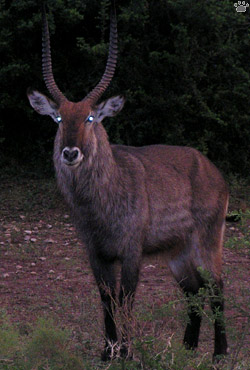
Waterbuck (Kobus ellipsiprymnus),
Queen Elizabeth Nat'l Park, Uganda. |
There are a few things you can try. If you don't want to engage into anything illegal or even marginally legal, try driving just outside the park borders. There used to be almost as many animals there as inside, but in the last decade larger species were mostly killed off for bushmeat trade. The smaller ones are still there. In Kenya, try roads around Masai Mara Nat'l Reserve, access roads to Amboseli Nat'l Park (especially from the east), Lake Baringo area and roads in the far North. In Tanzania, the road to Lake Natron and backcountry roads north from Kigoma; in Uganda - roads of Semiliki area. |
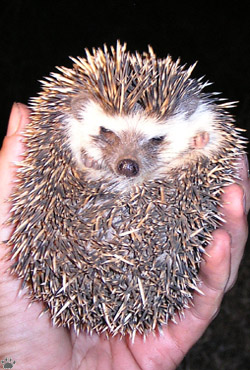
Small African hedgehog (Atelerix albiventris),
Amboseli Nat'l Park access road. |

Baby chameleon, Parc Nacional Des Volcans, Rwanda. |

Chameleon, Serengeti National Park, Tanzania. |
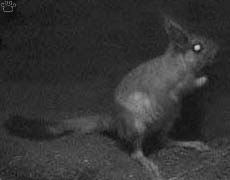
Springhare (Pedetes capensis) is one of Africa's largest
and most common rodents. Hell's Gate Nat'l Park. |
Driving at night inside the parks is technically illegal, so prepare a good story in case you run into an anti-poaching squad (which is less likely to happen in remote areas of large parks such as Serengeti, Masai Mara, or Aberdare). "Being lost" is usually sufficient. In Serengeti, you can drive until 10 PM if you are going to the canteen in Seronera to get drunk! |
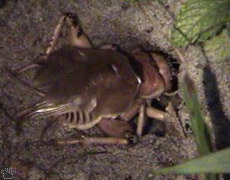
Calls of giant crickets can be heard from three miles
away. Arabuko-Sokoke Forest Reserve, Kenya. |

African scops owl (Otus senegalensis), is the most common small owl
in Seronera area of Serengeti National Park. |

Giant genet (Genetta victoriae) is rare, but smaller species are very common
in E Africa. Nyungwe Forest National Park, Rwanda. |
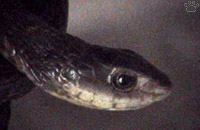
Boomslang (Dispholidus typus),
Mount Kilimanjaro National Park, Tanzania. |
If you can't drive around at night, try to do it as early as possible in the morning, and as late as possible in the evening. Evenings are usually good for reptiles, especially snakes crossing roads; mornings - for birds and many other creatures. Drive very slowly to make sure you don't harm any nightjars, frogs, or other roadkill-prone animals. |
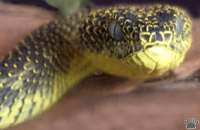
Mount Kenya bush viper (Atheris desaixi),
Mount Kenya National Park, Kenya. |
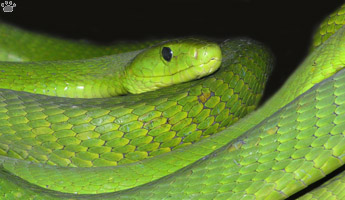
Eastern green mamba (Dendroaspis angusticeps), Kakamega Forest Nat'l Park, Kenya. |

Black mamba (D. polylepis), Udzungwa Mountains National Park, Tanzania. |

Gabon viper (B. gabonica), Mikumi National Park, Tanzania. |
Note that snakes and most other reptiles can be difficult to find in many parts of East Africa during the cold season (late June to early September). |
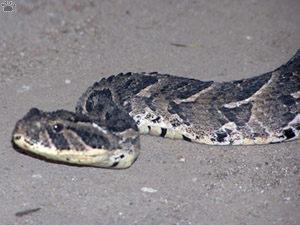
Puff adder (B. arietans), Moyowosi Game Reserve, Tanzania. |
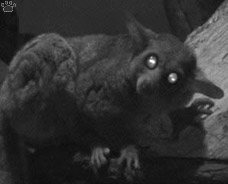 |
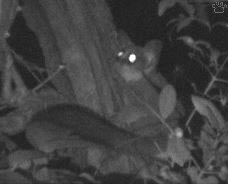 |
 |
| Africa has lemurs, too! Left to right: Eastern greater bushbaby (Otolemur garnettii), common bushbaby (Galago senegalensis), Eastern dwarf galago (Galagoides zanzibaricus). Arabuko-Sokoke Forest Reserve, Kenya. |
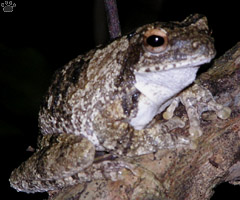
Uzambara tree frog (Parhoplophryne uzambarica),
Uzambara Mountains Forest Reserve, Tanzania. |
If you want to walk around, it's better to sneak out of your campground after midnight, when everybody is asleep. Nights with full moon are better for savanna parks, where moonlight allows you to use flashlight only when you see something, so you are less likely to be noticed by animals and rangers. In forest parks, it doesn't really matter. |
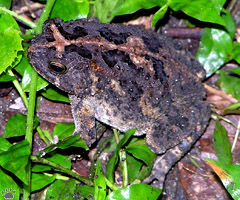
Bunti's dwarf toad (Mertensophryne micranotis),
Udzungwa Mountains National Park, Tanzania. |
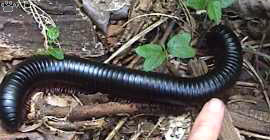 |
 |
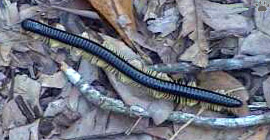 |
| Giant millipedes (left and center - Archispilostreptus gigas, right - unidentified) are very common in Eastern Ark forests. Uluguru Mountains, Tanzania. |
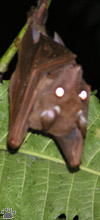 |
 |
Forest parks often have more relaxed restrictions. The ones along the coast (Arabuko-Sokoke in Kenya, Jozani and Ngezi in Tanzania, etc.) and in the Eastern Ark Mountains of Tanzania (Uzambara, Uluguru, Udzungwe) have lots of endemics, but you have to be a professional to find and identify them. Mountain parks further west (many Rwandan and Ugandan parks, Kakamega in Kenya) have more endemics, plus many large animals. Semiliki Valley in Uganda is your best chance to see West African lowland rainforest if you do not dare cross into Congo-Zaire. |
 |
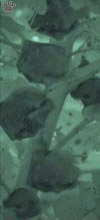 |
Epauletted fruit bats (Epomophorus minimus)
feeding on figs (Ficus). Semiliki Valley National
Park, Uganda. |
Dwarf epauletted fruit bats (Micropteropus
pusillus), Saiwa Swamp National Park, Kenya.
As most fruit bats, they spend days in tree roosts. |
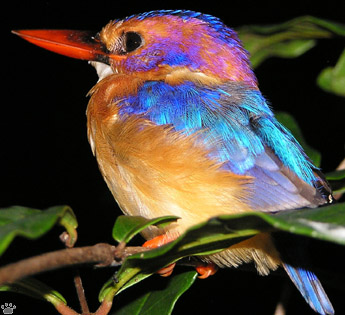
African pygmy kingfisher (Ceyx picta), Arabuko-Sokoke Forest Reserve. |
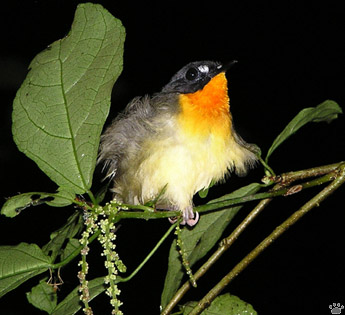
Forest robin (Stiphrornis erythrothorax) , Kibale Forest National Park, Uganda. |
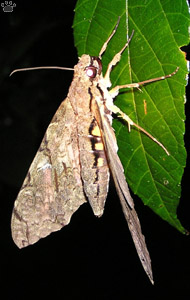
Hawk-moth, Semiliki Valley NP, Uganda. |
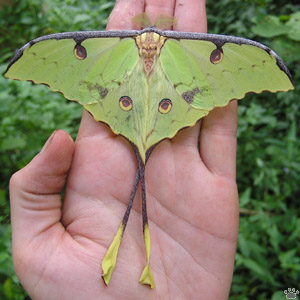
African comet moth (Argema mimosae), Arabuko-Sokoke FR, Kenya. |

Geometrid moth, Ngezi Forest, Pemba I. |

Elephant-apple tree
(Dillenia indica) has
naturalized in coastal East Africa, and is
very popular among nectar-feeding bats. |
African nights are full of wonders, and very few people wonder around to see them. There is always a chance of seeing something new or rare. Keep accurate records! Note, however, that your records or photos might be used as evidence against you if you are arrested and accused of getting without a permit into places like Mount Kilimanjaro National Park, Kenya, which is punishable by jail sentence. Most other parks would just slap you with a "park violation" fee, but it's better to avoid trouble. |
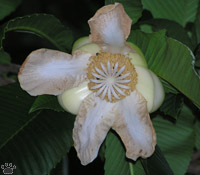
Its beautiful flowers open for a very short
time - sometimes just one night.
Uzambara Mts. |
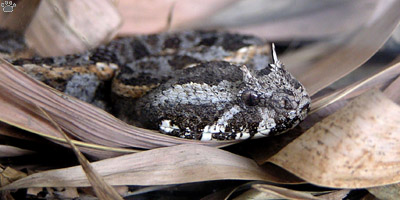
Rift Valley viper (B. worthingtoni), Lake Baringo, Kenya.
Part 3: Garbage Dumps
Back to Part 1
Home
|